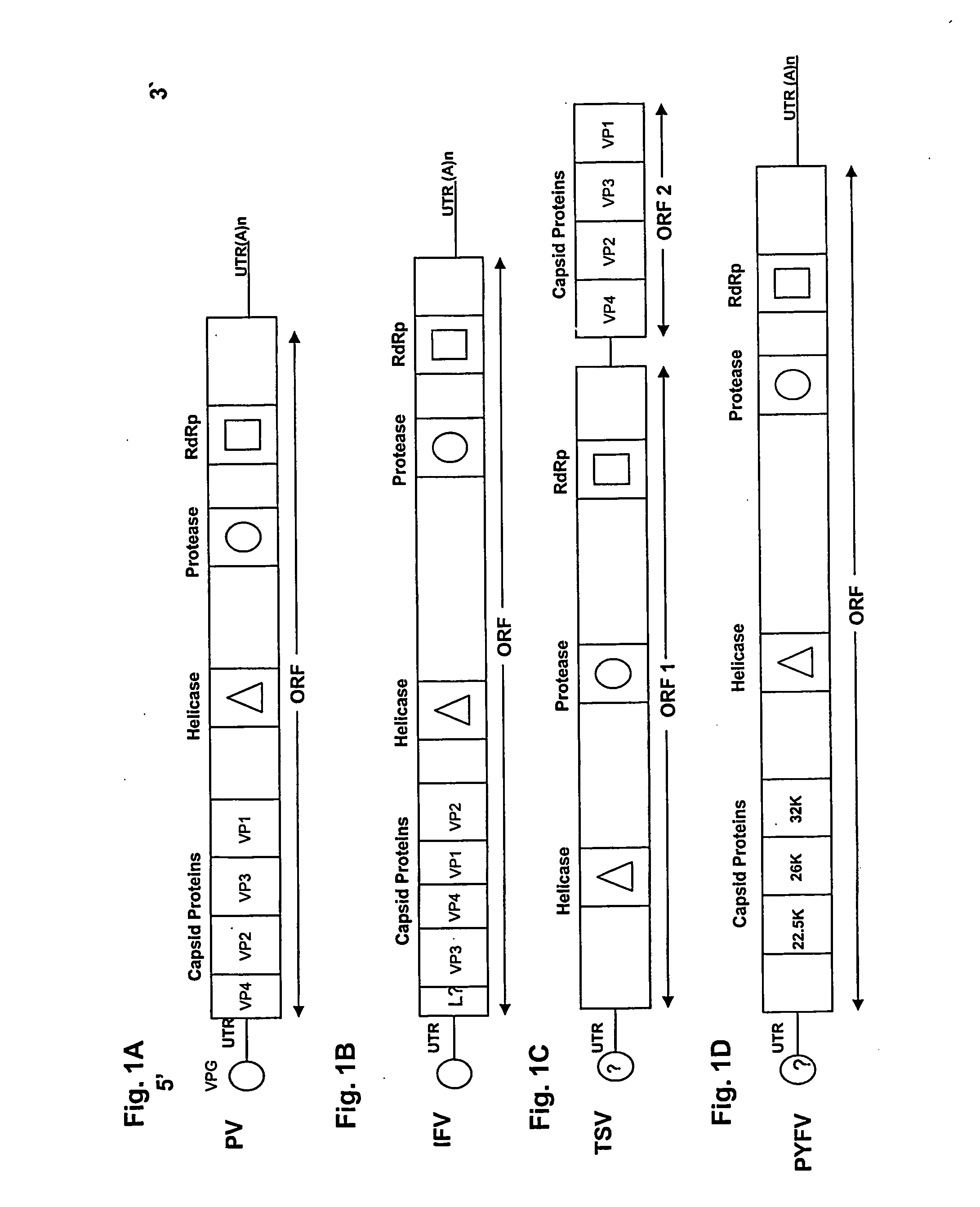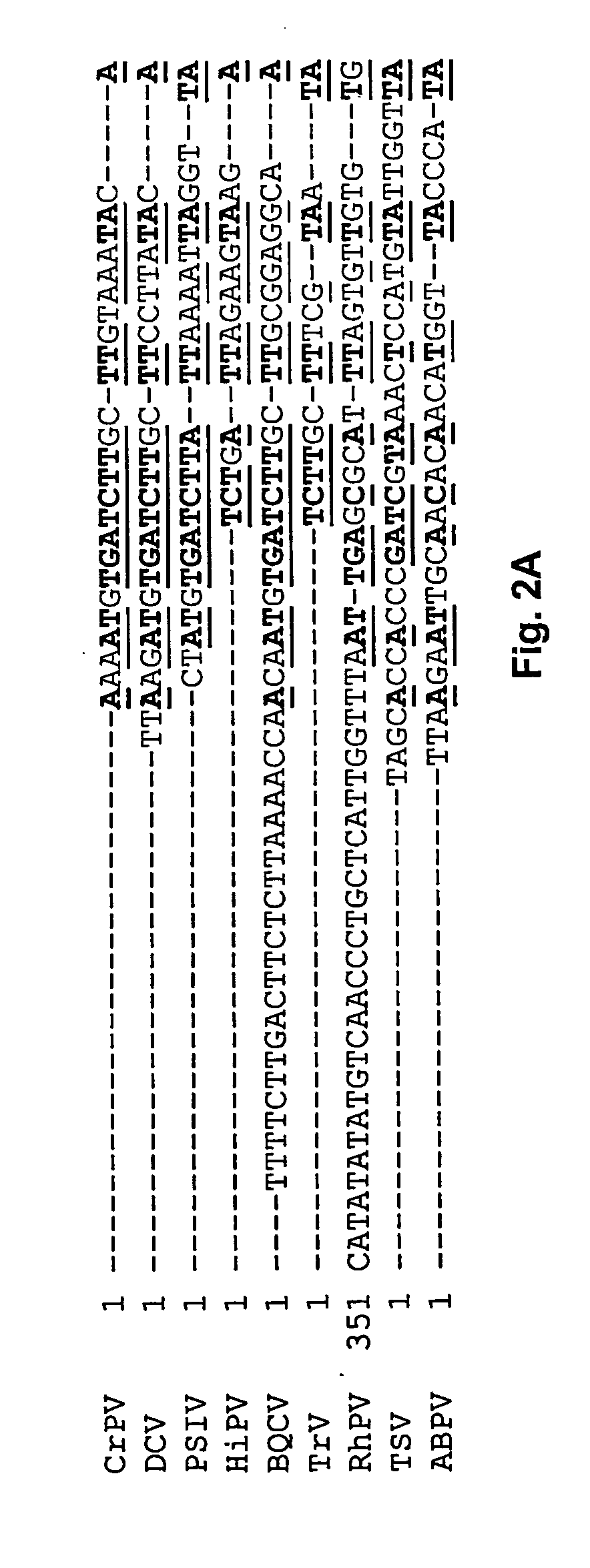Crustacean Expression Vector
a technology of expression vectors and crustaceans, applied in the field of crustacean expression vectors, can solve problems such as significant economic losses for commercial shrimp farmers, adverse effects on wild crustacean populations, and economic losses from viruses caused by diseases
- Summary
- Abstract
- Description
- Claims
- Application Information
AI Technical Summary
Benefits of technology
Problems solved by technology
Method used
Image
Examples
example 1
[0070] Identification of Internal Ribosomal Entry Site (IRES) Elements in TSV and Insect Picorna-Like Viruses.
[0071] Insect picornaviruses with dicistronic genomes have two unique features. First, no sub-genomic RNA is produced for translation of the capsid proteins. Second, the coat protein cistron appears to lack an initiating methionine suggesting that the coat protein is translated through internal initiation mediated by an internal ribosomal entry site (IRES).
[0072] Functional IRES elements have been identified in the intergenic region of CrPV and PSIV (Wilson et al., 2000, Mol. Cell. Biol. 20:4990-4999; Sasaki et al., 1999, J. Virol. 73:1219-1226), and homologous sequences have been identified in TSV (Mari et al., 2002, J. Gen. Virol. 83:915-926, FIG. 2). Cap-independent translation in PSIV ORF2 has been demonstrated in vitro using a rabbit reticulocyte lysate (Sasaki et al., 2000, Proc. Natl. Acad. Sci. USA 97:1512-1515). In CrPV, the initiation codon for IRES mediated tran...
example 2
[0077] Genome Organization of IHHNV
[0078] The IHHNV genome contains a single stranded linear DNA of 4.1 kb (Bonami et al., 1990). Almost the entire IHHNV genome except the 5′-and 3′-terminal ends has been sequenced (Shike et al., 2000, Virology, 277:167-177). There are three large open reading frames (ORFs) in the IHHNV genome (FIG. 3). The middle and the right ORFs are present in the plus 3 frame, whereas the left ORF is present in the plus 3 frame. The middle ORF completely overlaps with the left ORF, whereas the right ORF partially overlaps with the left ORF. The left, middle and the right ORFs have potential coding capacities of 666 amino acids (75.77 kDa), 363 aa (42.11 kDa) and 329 aa (37.48 kDa), respectively.
[0079] The left ORF most likely encodes for a major non-structural protein (NS-1), which contains replication initiation motifs, NTP-binding, and helicase domains. The right ORF encodes the capsid protein. The aa sequence of middle ORF does not show any similarity with...
example 3
[0080] Amplification of IHHNV P61 Promoter by Polymerase Chain Reaction (PCR)
[0081] In order to evaluate the promoter activity of IHHNV P61 promoter, a 166 bp DNA flanking the P61 promoter was designed. The sequence of the primers were: IHHNP61F: 5′-GGTAC CTCCA GCTGA TGGTA AAGCT-3′ (SEQ ID NO: 19; nucleotide position 2346-2371 in AF273215) and IHHNP61R: 5′-TTCGT ATTCT TGGAA GAGTC CTAG3″ (SEQ ID NO: 20; nucleotide position 2488 in AF273215). The reaction mixture for the PCR included 1× Promega thermophilic DNA polymerase buffer, 2.0 millimolar MgCl2, 0.4 micromolar dNTPs, 0.8 micromolar of forward and reverse primer, 7.5 units of Promega Taq DNA polymerase, and 100 nanograms of total genomic DNA isolated from IHHNV-infected shrimp in a 25 microliter reaction volume. The thermal profile for the PCR was 95 degrees Celsius for 5 minutes followed by 40 cycles of 95 degrees Celsius 30 seconds, 52 degrees Celsius 30 seconds, and 72 degrees Celsius 1 minute before cooling at 4 degrees Cels...
PUM
| Property | Measurement | Unit |
|---|---|---|
| Fraction | aaaaa | aaaaa |
| Fraction | aaaaa | aaaaa |
| Fraction | aaaaa | aaaaa |
Abstract
Description
Claims
Application Information
 Login to View More
Login to View More - R&D
- Intellectual Property
- Life Sciences
- Materials
- Tech Scout
- Unparalleled Data Quality
- Higher Quality Content
- 60% Fewer Hallucinations
Browse by: Latest US Patents, China's latest patents, Technical Efficacy Thesaurus, Application Domain, Technology Topic, Popular Technical Reports.
© 2025 PatSnap. All rights reserved.Legal|Privacy policy|Modern Slavery Act Transparency Statement|Sitemap|About US| Contact US: help@patsnap.com



